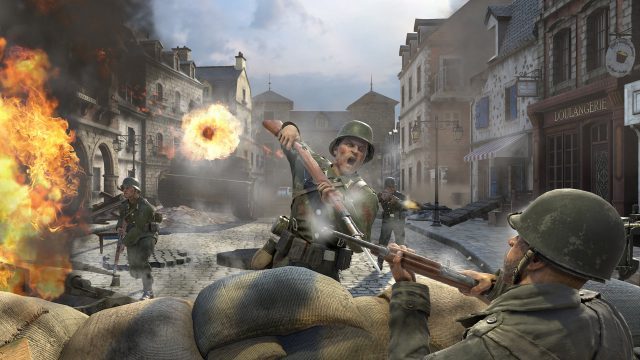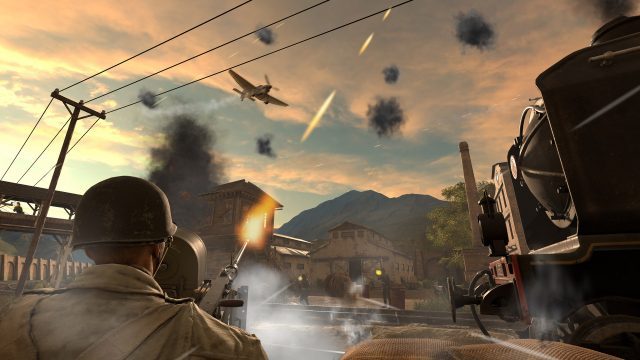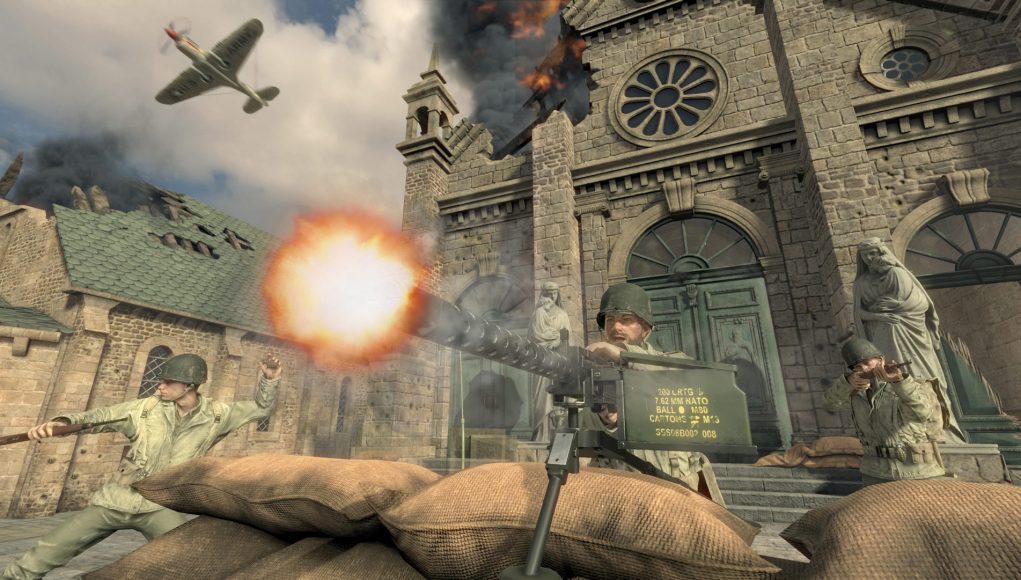Having announced ‘Vive Studios’ at the end of 2016, HTC is steadily building up its first-party VR content offering. After a number of relatively well received titles launched under the umbrella of Vive Studios, we take the latest, Front Defense VR, for a test drive.
What is it that makes the HTC Vive special and different from the other VR platforms on the market? It depends who you ask. It used to be the tracked motion controllers, but that is no longer the case. Is it the room-scale? That’s a huge plus for sure, but with a little jiggery-pokery the Rift can get close enough for some people. Is it the tracking? This at least is still best in class, for my money. Content? While you might argue that Rift and PSVR with their exclusives rule the roost here, there’s still much to recommend the Vive ecosystem.
Crawling around on hands and knees behind the virtual sandbags of Front Defense VR, there’s no need to wonder how HTC would answer the question. With its first release from internal developer Fantahorn Studio for the Vive, we find that the answer is resounding: room-scale. Specifically a play area so large that no competing platforms can come close. Hope you’ve got a nice big play space, people, because anything less than three metres square just ain’t gonna cut it with Front Defense VR. Time to build that underground VR bunker in the garden.
Front Defense VR Details:
Publisher: HTC / Vive Studios
Developer: Fantahorn Studio
Available On: HTC Vive (Viveport, Steam)
Reviewed On: HTC Vive (Steam)
Release Date: June 27, 2017 (Viveport), July 7th (Steam)
Gameplay
Front Defense VR is a World War II shooter spread over three (yes, just three) stages, and your position is entirely static so there is no question about methods of locomotion or anything like that—it’s completely ‘real’ locomotion within your room-scale playspace. For the vast majority of the time you’ll be hunkered down within your small sandbagged enclosure to avoid being riddled with bullets. You’ll pop up occasionally to start thinning out the waves of enemy troops that will swarm the area in increasing number as the situation escalates from foot soldiers to motor vehicles, mortars, armoured cars, tanks, and strafing runs from squadrons of enemy planes.
Standing against this tide of enemy combatants are you and a motley crew of anonymous friendly soldiers that appear around you, there to provide the illusion of a cinematic battle just like all the other militaristic shooters of the last two decades. There’s not much going on in their heads though, and the stilted animation fails to convince. Likewise with the enemy soldiers, their behaviours much more in line with arcade classic Operation Wolf (1987) than anything more contemporary. That’s not necessarily a bad thing in an arcade shooter.
There’s nothing to link the three stages, they exist as standalone entities and entertain to varying degrees. There’s no attempt at real depth aside from score attack leaderboards, but it really does scratch that score attack itch—it’s fun to go back into the stages and eke out a little more progress, to see the scenario escalate another notch, to survive against increasingly ridiculous odds.
My favourite is actually the first scenario, a relatively simple setup on some classically European back streets, with enemies appearing on balconies, from side streets, around corners and through distant archways. While the second encounter—defending an HQ inside a church that opens onto a town square—adds in the ability to call in an airstrike, it lacks the focus of the first. The rail yard of the third encounter, with its strafing aircraft, introduces move overt destructible scenery and acts as a challenging climax.
The weapons at your disposal are drawn from predictable stock: a pistol, a rifle, a bazooka, some grenades, and the odd fixed emplacement, like a mounted machinegun. Each is enjoyable enough to fire, with a convenient red dot projected onto enemies for the pistol and rifle making it easier to pick off distant targets. The fact that fixed emplacements are located near to the edges of the play space means that if your physical area is hemmed in by walls or furniture then you won’t be able to fully interact with and aim these elements so easily.
Most weapons are picked up by reaching into them and picking them up with the trigger which then locks the weapon to your hand while the trigger reverts to its traditional firing role. Reloading the rifle is as simple as ripping out the old clip, grabbing a new one from your side, and ramming it home. This is the best of the bunch, and feels as intuitive as some of the best games in the genre. The pistol uses a press of the touchpad to release a clip but you can’t fully slide the new clip in because you’d crash the two controllers together, so you’re left with the unsatisfying act of holding it near the bottom of the gun and releasing it to reload.
Not that loading the rifle is easy all the time; the game does its best to guess where your waistline is based on head and hand positions, but all too often the ammo belt actually appeared ‘inside’ me as I was crouched down, making it impossible to retrieve ammo without committing accidental seppuku with my Vive controller. Even aiming the fixed weapons can be fraught: if you move your hands too far away from the handle you become detached, and it’s often a second or two before you realise what has happened.
How Front Defense VR handles grenades must have sounded awesome in the planning meeting… “Guys, I’ve had a great idea! Let’s get the player to pull the pin out with their teeth before throwing the grenade!” Sadly the reality—after a few aborted attempts at punching oneself in the face—is that you sort of hover the hand grenade in front of your nose for a second until you hear the pin eject. It gets the job done, but it’s a far cry from the marketing vision. The bazooka suffers a similar fate, with the loading of a rocket into the rear of the weapon reduced to simply holding it in the rough vicinity and letting go, whereupon it instantly disappears into the tube. It’s pragmatic, but not exactly immersive.
Actually, the whole experience falls well underneath the expected bar for quality in mid-2017. It’s a small scale, uninspiring setup in a fairly crowded genre, riddled with some of the hoariest clichés of VR interaction and a strangely ugly 2D menu system with incongruous blue floating buttons. The visuals can’t be configured in any way, so supersampling isn’t an option for people on more capable machines. As a result, prepare to squint at distant, muddy pixels as you try to figure out which burnt out window frame the enemy soldier is occupying, or which piece of cover they are hunkered down behind.
Note: we’ve asked the developers to confirm that the lack of any graphical settings isn’t just a limitation of our review copy, and will update when we hear back. It’s possible some auto-setting of detail is in play, but if so my 980Ti was still sadly underutilised.
 Mostly it’s just more of the same that we’ve seen before. There are occasional moments where the game’s own blend of enemy waves and the excitement of being hunkered down in such a large play space combine to truly immerse you in the moment, but it doesn’t last long. There’s never a sense of danger. Death often comes as something of a surprise, usually via an enemy soldier with a bayonet that manages to evade attention and puncture your spleen.
Mostly it’s just more of the same that we’ve seen before. There are occasional moments where the game’s own blend of enemy waves and the excitement of being hunkered down in such a large play space combine to truly immerse you in the moment, but it doesn’t last long. There’s never a sense of danger. Death often comes as something of a surprise, usually via an enemy soldier with a bayonet that manages to evade attention and puncture your spleen.
The biggest missed opportunity of all is that the developers have doubled-down on the large play area, but then only really used half of it. Only the area in front of the player is meaningfully utilised, with no threats ever coming from behind. It suits the nature of the game—defending fixed entrenchments, which logically would be set up to defend against one direction—but does seem at odds with a clear mission to promote the awesomeness of the Vive’s room-scale tracking capabilities.
There’s potential here, but it needs more iteration and polish. It needs more unique content, or even clever reuse of what’s there. Mostly it needs a package that ties it all together in a more interesting fashion than these three isolated stages. There’s fun here for sure, but I’m not really certain what Front Defense VR brings to the party beyond its commitment to a large play area. It’s as fun to shoot things in VR as it ever was, but as the market has matured a little over the last year, so too have our expectations, and Front Defense VR sadly fails to meet them.
Immersion
 When it all comes together, Front Defense VR does decent job of convincing you that you’re in a war zone, battling against the odds. As much as I’m not a believer that the majority of Vive owners have the sort of space this game demands, I have to admit that if you do, it’s on another level compared to other experiences. Being set within a large fixed space really aids the immersion—if you happen to have a few dozen sandbags to hand you could probably concoct the ultimate version of this experience.
When it all comes together, Front Defense VR does decent job of convincing you that you’re in a war zone, battling against the odds. As much as I’m not a believer that the majority of Vive owners have the sort of space this game demands, I have to admit that if you do, it’s on another level compared to other experiences. Being set within a large fixed space really aids the immersion—if you happen to have a few dozen sandbags to hand you could probably concoct the ultimate version of this experience.
It’s not all roses though. Accidentally squeezing the hand grip in the heat of battle and unintentionally dropping the weapon while under heavy assault? Immersion killer. Clanging controllers together when reloading the pistol? Immersion killer. Smashing a controller into the headset when trying to prime a grenade? Immersion killer. The same two or three sounds/barks issuing in quick succession? Immersion killer. Trying to aim a fixed machine gun mounted in a corner of the play area and smacking into a wall? Immersion killer. Stilted people animations? Immersion killer.
Many of these issues have been solved by other developers, and clear solutions exist. Quite why the developers in this case have persisted with such obviously bad design decisions remains a mystery.
To end on a high note, though, the necessity to get down low and crawl around on the floor a little really helps to set the experience apart from others that are primarily standing. In this regard at least, the game is in rare company.
Comfort
As there is zero artificial locomotion, comfort is perfectly fine throughout. The only caveat is that—if you intend to survive for more than ten seconds in the game—you will need to get down low either by crouching or crawling around on the floor. Depending on your fitness (my aging bones were protesting at the end of a protracted session with the game!) this may or may not be an issue. Knee pads optional.
 We partnered with AVA Direct to create the Exemplar 2 Ultimate, our high-end VR hardware reference point against which we perform our tests and reviews. Exemplar 2 is designed to push virtual reality experiences above and beyond what’s possible with systems built to lesser recommended VR specifications.
We partnered with AVA Direct to create the Exemplar 2 Ultimate, our high-end VR hardware reference point against which we perform our tests and reviews. Exemplar 2 is designed to push virtual reality experiences above and beyond what’s possible with systems built to lesser recommended VR specifications.







